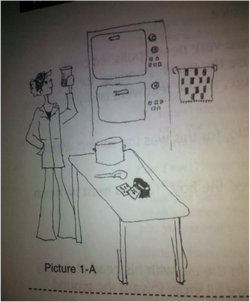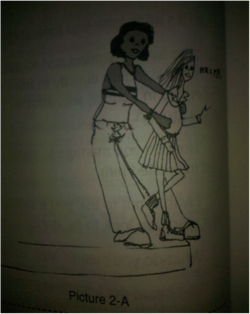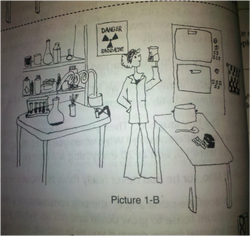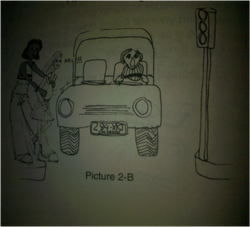Faces of a Family
Lesson 1: What does it family mean?
Unit Essential Questions: What does family mean? How are families alike and different?
Lesson Essential Questions: What does family mean? Does family always mean the same thing?
Time needed: 3 class periods
NCSS Standards:
address similar human needs and concerns.
MMSD Standards:
UW Teaching Standards
Materials
Objectives
Lesson Context:
This lesson is the introduction to a unit on families. The introductory lesson is specifically aimed at looking at the definition of “family” and how this definition may differ if looked at from different perspectives.
Lesson Opening:
o Ask each question and tell students they will have a little time to think about it in their head. I
want you to think about this question in your head first. I will give you 5 counts (count down on fingers
slowly) to think to yourself. Does anyone have an idea they want to share?
o Move on to the next question if students are getting off subject or there is a lull in the
conversation.
are talking about? What makes you think that?
keep thinking about what it means to be a family. I will leave this list of ideas up and we can add to it or
change it if we think we need to.
Note: The lesson will break here and resume the following day.
Procedure:
§ Give each student a copy of picture 1-A and 2-A.
§ I want you to look at these pictures and think about them to yourself. How do you feel about this
picture? What do you think is happening in these pictures? You can write down your answers or you
can just think about them in your head.
§ Have students share in small groups. After students have a couple of minutes to share, have
students compare their answers with their peers’.
§ Finally, have a whole group discussion about students’ ideas and feelings.
o Give students a copy of picture 1-B
§ Now I want you to work on your own again. I want you to look at the new picture and the one I gave
you first and think about what is going on. Have your ideas changed now? How have your ideas
changed? Why do you think your ideas might have changed?
· Be sure to discuss that seeing more of the picture lets you learn more about what is
going on.
§ Have small group discussion and then whole group discussion. Repeat with picture 2-B.
o Whole-class discussion
§ What was the difference in your ideas about the pictures when you saw part of the picture and then
when you saw the whole picture?
§ Why was there a difference?
§ Sometimes in real life we do not know everything that is going on and we cannot see what is actually
happening. For example, we might think that because someone doesn’t live with their dad that means
that they do not have a dad. But if we learn more about that person by talking to them, we might learn
that their dad has to work at a job in a different city and that is why they don’t live together. It is
important to learn everything you can before you start guessing about what is going on because
sometimes that can hurt people.
§ We can also learn from these pictures that sometimes certain things can mean different things for
different people. When *** looked at the first picture, he saw a kitchen and a cook. When *** saw this
picture he saw a scientist. There was more than one way to look at the picture and more than one right
answer. This can be the same in our lives. For example, my family has 5 people in it but ***’s family
has 3 people in it. Are both of these still a family?
*Note: The lesson will break here and will resume for the next portion.
concepts.
§ Does anyone have anything to add to this list?
o I’m going to read a book to you and I want you to think about what it means to be a family. I also want you
to think about what we did yesterday with the different pictures. Remember that you might not always have the
same idea as someone else about what it means to be a family. Let’s see if we can listen to the book and think
about what family means to the people in this story.
o Read “One Hundred is a Family” by Pam Muñoz Ryan
§ “Three is a family counting the sparkling stars at night.”
· When we are reading remember to examine the pictures. This picture shows a family looking at
the stars. There is a daughter and two moms in this family.
§ “Seven is a family keeping traditions of the past.”
· What is a tradition? A tradition is something that a family or classroom or a group of people do
the same way on a special occasion. For example, my family always eats ice cream cake on my
birthday. What do you eat special on your birthday? Take 2 or 3 answers.
§ “Forty is a family bringing the ripened harvest in.”
· The people in this family really look like they are helping each other. How do you help your
family? Turn and share with your partner.
§ “Seventy is a family fixing a festive place to meet.”
· I want you to think in your head. Who is in this picture? Are they all in one family? Why or
why not? Talk to partner first and then whole group discussion.
§ “Ninety is a family knowing they all belong.”
· What does it mean to belong?
· Is this the same type of family that we have been talking about? What is the same or different?
Lesson Closure:
etc.
o Ask for questions. Clarify any vocabulary or ideas from the book and discussions that children do
not understand.
Assessment:
For this lesson students will be assessed informally. The teacher can listen in on small group discussions, as well as take notes on responses during whole group discussion. Some students may feel more comfortable speaking out in a small or whole group discussion than in the other and students should not be assessed solely on their participation in one of these formats, but should instead be assessed on their overall contribution.
Special Considerations:
Resources:
Ryan, P. M. (1994). One hundred is a family. New York: Hyperion Paperbacks for Children.
This picture book introduces families of different sizes, from one person to a group of 100 people. It also provides a great introduction to a discussion on the meaning of family. This book shows families of traditional size, but also highlights the importance of a neighborhood, school, community, and global family. I am using it as a read aloud for this lesson, but it is also a book I would keep out for students to read on their own.
Schniedewind, N. & Davidson, E. (2006). Open minds to equality: A sourcebook of learning activities to affirm
diversity and promote equity. Wisconsin: Rethinking Schools, Ltd.
This book is a great resource for anyone thinking about teaching equality and social justice in their classroom. It includes resources and activity ideas for topics such as creative cooperation, looking at new perspectives, discrimination, and the important fact that we can all make change happen. I will be using this book to guide some of the activities throughout my unit. Specifically to this lesson, I adapted an activity from the book called, “What’s in the picture?” to introduce the idea of different perspectives and “seeing the whole picture.”
NCSS Standards:
- I. Culture: Social studies programs should include experiences that provide for the study of cultural diversity so that the learner can
address similar human needs and concerns.
MMSD Standards:
- Grade 1 Behavioral Sciences
UW Teaching Standards
- Standard 1: Incorporates understanding of human learning and development
- Standard 4: Demonstrates pedagogical knowledge in specific domains
- Standard 9: Manages learning environment
Materials
- Chart paper
- Markers
- Copies of pictures (see attached)
- “One Hundred is a Family” by Pam Muñoz Ryan
Objectives
- Students will discuss the meaning of “family.”
- Students will respectfully participate in large and small group discussions.
- Students will learn that people may have different perspectives than their own.
- Students will identify different types and meanings of families.
Lesson Context:
This lesson is the introduction to a unit on families. The introductory lesson is specifically aimed at looking at the definition of “family” and how this definition may differ if looked at from different perspectives.
Lesson Opening:
- Begin discussion with students about the meaning of family.
o Ask each question and tell students they will have a little time to think about it in their head. I
want you to think about this question in your head first. I will give you 5 counts (count down on fingers
slowly) to think to yourself. Does anyone have an idea they want to share?
o Move on to the next question if students are getting off subject or there is a lull in the
conversation.
- Allow for open discussion. Jot down bits of discussion or key words on the board and refer to them during the discussion as terms or important concepts are repeated (for example, many students may talk about having brothers and sisters, love, and being together.)
- To facilitate discussion:
are talking about? What makes you think that?
- Wrap up discussion
keep thinking about what it means to be a family. I will leave this list of ideas up and we can add to it or
change it if we think we need to.
Note: The lesson will break here and resume the following day.
Procedure:
- What’s in the Picture?
§ Give each student a copy of picture 1-A and 2-A.
§ I want you to look at these pictures and think about them to yourself. How do you feel about this
picture? What do you think is happening in these pictures? You can write down your answers or you
can just think about them in your head.
§ Have students share in small groups. After students have a couple of minutes to share, have
students compare their answers with their peers’.
§ Finally, have a whole group discussion about students’ ideas and feelings.
o Give students a copy of picture 1-B
§ Now I want you to work on your own again. I want you to look at the new picture and the one I gave
you first and think about what is going on. Have your ideas changed now? How have your ideas
changed? Why do you think your ideas might have changed?
· Be sure to discuss that seeing more of the picture lets you learn more about what is
going on.
§ Have small group discussion and then whole group discussion. Repeat with picture 2-B.
o Whole-class discussion
§ What was the difference in your ideas about the pictures when you saw part of the picture and then
when you saw the whole picture?
§ Why was there a difference?
§ Sometimes in real life we do not know everything that is going on and we cannot see what is actually
happening. For example, we might think that because someone doesn’t live with their dad that means
that they do not have a dad. But if we learn more about that person by talking to them, we might learn
that their dad has to work at a job in a different city and that is why they don’t live together. It is
important to learn everything you can before you start guessing about what is going on because
sometimes that can hurt people.
§ We can also learn from these pictures that sometimes certain things can mean different things for
different people. When *** looked at the first picture, he saw a kitchen and a cook. When *** saw this
picture he saw a scientist. There was more than one way to look at the picture and more than one right
answer. This can be the same in our lives. For example, my family has 5 people in it but ***’s family
has 3 people in it. Are both of these still a family?
*Note: The lesson will break here and will resume for the next portion.
- One Hundred is a Family
concepts.
§ Does anyone have anything to add to this list?
o I’m going to read a book to you and I want you to think about what it means to be a family. I also want you
to think about what we did yesterday with the different pictures. Remember that you might not always have the
same idea as someone else about what it means to be a family. Let’s see if we can listen to the book and think
about what family means to the people in this story.
o Read “One Hundred is a Family” by Pam Muñoz Ryan
§ “Three is a family counting the sparkling stars at night.”
· When we are reading remember to examine the pictures. This picture shows a family looking at
the stars. There is a daughter and two moms in this family.
§ “Seven is a family keeping traditions of the past.”
· What is a tradition? A tradition is something that a family or classroom or a group of people do
the same way on a special occasion. For example, my family always eats ice cream cake on my
birthday. What do you eat special on your birthday? Take 2 or 3 answers.
§ “Forty is a family bringing the ripened harvest in.”
· The people in this family really look like they are helping each other. How do you help your
family? Turn and share with your partner.
§ “Seventy is a family fixing a festive place to meet.”
· I want you to think in your head. Who is in this picture? Are they all in one family? Why or
why not? Talk to partner first and then whole group discussion.
§ “Ninety is a family knowing they all belong.”
· What does it mean to belong?
· Is this the same type of family that we have been talking about? What is the same or different?
Lesson Closure:
- From reading this book we got to think about family in different ways. Can we add anything to our list of what it means to be a family?
etc.
o Ask for questions. Clarify any vocabulary or ideas from the book and discussions that children do
not understand.
Assessment:
For this lesson students will be assessed informally. The teacher can listen in on small group discussions, as well as take notes on responses during whole group discussion. Some students may feel more comfortable speaking out in a small or whole group discussion than in the other and students should not be assessed solely on their participation in one of these formats, but should instead be assessed on their overall contribution.
Special Considerations:
- Place students in groups so that there is a mix of students’ abilities and backgrounds. This will help discussion.
- Refer back to the vocabulary list, especially for English Language Learners, during writing and discussion times. Hopefully having the words posted, as well as hearing them multiple times, will help everyone become more comfortable with their use.
Resources:
Ryan, P. M. (1994). One hundred is a family. New York: Hyperion Paperbacks for Children.
This picture book introduces families of different sizes, from one person to a group of 100 people. It also provides a great introduction to a discussion on the meaning of family. This book shows families of traditional size, but also highlights the importance of a neighborhood, school, community, and global family. I am using it as a read aloud for this lesson, but it is also a book I would keep out for students to read on their own.
Schniedewind, N. & Davidson, E. (2006). Open minds to equality: A sourcebook of learning activities to affirm
diversity and promote equity. Wisconsin: Rethinking Schools, Ltd.
This book is a great resource for anyone thinking about teaching equality and social justice in their classroom. It includes resources and activity ideas for topics such as creative cooperation, looking at new perspectives, discrimination, and the important fact that we can all make change happen. I will be using this book to guide some of the activities throughout my unit. Specifically to this lesson, I adapted an activity from the book called, “What’s in the picture?” to introduce the idea of different perspectives and “seeing the whole picture.”




